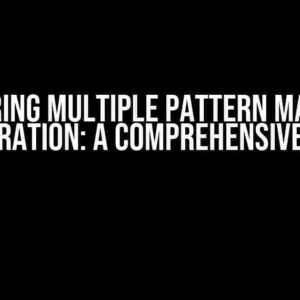Type erasure and parameterized protocols are two fundamental concepts in Swift programming. While they may seem similar, they serve distinct purposes and are essential in different scenarios. In this article, we’ll delve into the world of type erasure and parameterized protocols, exploring their differences, and why we need type erasure despite having parameterized protocols.
Understanding Parameterized Protocols
Parameterized protocols, also known as generic protocols, allow you to define a protocol with type parameters. This enables you to create reusable and flexible protocols that can work with various types. Here’s an example:
protocol Container<T> {
associatedtype ItemType
var items: [ItemType] { get set }
mutating func append(_ item: ItemType)
}In this example, the `Container` protocol is defined with a type parameter `T`. This allows you to create containers that can hold different types of objects, such as integers, strings, or custom types.
The Limitations of Parameterized Protocols
While parameterized protocols are powerful, they have some limitations. One of the main drawbacks is that they can’t be used as types in and of themselves. This means you can’t use a parameterized protocol as a function parameter, return type, or property type. For instance:
func processContainer(_: Container<Int>) { /* error: protocol 'Container' can only be used as a generic constraint */ }This limitation arises from the fact that parameterized protocols are not types; they’re more like blueprints for types. To overcome this limitation, we need type erasure.
Introducing Type Erasure
Type erasure is a technique used to abstract away the underlying type of a value, allowing you to work with values of different types in a more flexible way. In Swift, type erasure is typically achieved using the `Any` keyword, along with the `some` keyword introduced in Swift 5.7. Here’s an example:
struct AnyContainer {
let _box: Any
init<T>(_ container: Container<T>) {
_box = container
}
}In this example, the `AnyContainer` struct uses type erasure to store a container of any type. The `_box` property holds the underlying container, and the `init` method allows you to create an `AnyContainer` instance from any type of container.
Why Do We Need Type Erasure?
Type erasure is necessary for several reasons:
- Protocol Types as First-Class Citizens: Type erasure enables protocol types to be treated as first-class citizens, allowing you to use them as function parameters, return types, or property types.
- Decoupling: Type erasure helps decouple your code from specific types, making it more flexible and reusable.
- Polymorphism: Type erasure enables polymorphism, which is the ability of an object to take on multiple forms. This allows you to write more generic code that can work with different types.
- Composition: Type erasure facilitates composition, where you can combine multiple types to create a new, more complex type.
When to Use Type Erasure vs. Parameterized Protocols
So, when should you use type erasure, and when should you use parameterized protocols? Here’s a simple rule of thumb:
| Scenario | Type Erasure | Parameterized Protocols |
|---|---|---|
| Need to work with protocol types as first-class citizens | ||
| Require polymorphism and decoupling | ||
| Need to define a protocol with type parameters | ||
| Want to create a reusable and flexible protocol |
In general, use type erasure when you need to work with protocol types as first-class citizens, require polymorphism and decoupling, or need to create a more flexible and reusable protocol. Use parameterized protocols when you need to define a protocol with type parameters.
Best Practices for Type Erasure
When using type erasure, keep the following best practices in mind:
- Use `Any` and `some` wisely: Only use `Any` and `some` when necessary, as they can lead to type ambiguity and make your code harder to understand.
- Keep type erasure local: Limit type erasure to specific parts of your codebase, rather than making it a global convention.
- Use type erasure for protocols only: Type erasure is primarily useful for protocols; avoid using it with structs or classes.
- Avoid over-erasure: Only erase the types that are necessary; excessive erasure can lead to type ambiguity and make your code harder to maintain.
Conclusion
In conclusion, type erasure and parameterized protocols are two essential concepts in Swift programming. While they may seem similar, they serve distinct purposes and are essential in different scenarios. By understanding the limitations of parameterized protocols and the benefits of type erasure, you can write more flexible, reusable, and maintainable code. Remember to use type erasure wisely, keeping in mind the best practices outlined above.
By mastering type erasure and parameterized protocols, you’ll be able to tackle complex programming challenges with confidence, creating more robust and scalable software systems.
So, why do we need type erasure given we already have parameterized protocols? The answer is simple: type erasure provides a way to abstract away the underlying type of a value, enabling you to work with protocol types as first-class citizens. This, in turn, opens up new possibilities for polymorphism, decoupling, and composition, making your code more flexible, reusable, and maintainable.
Frequently Asked Question
Get ready to dive into the world of type systems and generics!
Why can’t we just use parameterized protocols instead of type erasure?
While parameterized protocols do allow for some level of generic programming, they have limitations. With type erasure, the type information is removed at compile-time, making it possible to have a single implementation that works for all types, whereas parameterized protocols would require a separate implementation for each type.
Don’t parameterized protocols provide type safety, which is what we need?
Yes, parameterized protocols do provide type safety, but they can lead to code duplication and increased complexity. Type erasure, on the other hand, allows for a single implementation that is type-safe, without the need for separate implementations for each type.
Is type erasure not just a workaround for language limitations?
Type erasure is often misunderstood as a workaround, but it’s actually a deliberate design choice that allows for more flexibility and expressiveness in generic programming. It’s not just a hack to overcome language limitations, but a powerful tool that enables developers to write more concise and effective code.
What about the performance implications of type erasure?
While type erasure can lead to some performance overhead due to the extra indirection, it’s a small price to pay for the flexibility and convenience it provides. In many cases, the performance impact is negligible, and the benefits of type erasure far outweigh the costs.
Can’t we just use something like dynamic typing instead of type erasure?
Dynamic typing is an entirely different beast! While it provides flexibility, it also sacrifices type safety and can lead to runtime errors. Type erasure, on the other hand, provides a middle ground that balances flexibility with type safety, making it a more appealing choice for many developers.






